This post may contain affiliate links. Please see our disclosure policy.
Canning split pea soup puts a hearty, home cooked comfort food meal right on your pantry shelf when you need it. Properly pressure canned, split pea soup is shelf stable and ready to heat and eat anytime.
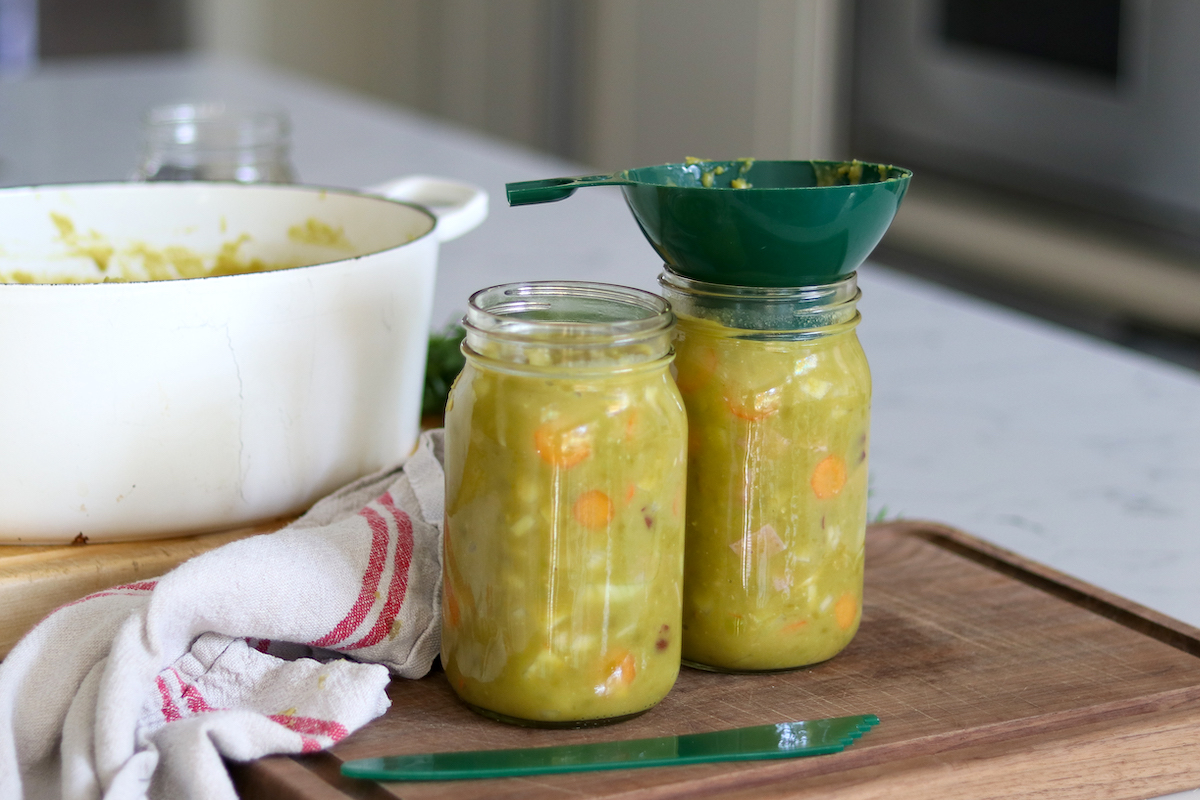
Split pea soup is one of those comfort food meals that’s perfect for warming you inside and out. I love making it on cold winter nights, especially when I come in chilled to the bone after shoveling snow during our long Vermont winters.
Start to finish, split pea soup takes more than an hour to cook…but it’s ready in just minutes if you’ve put in the time canning split pea soup earlier in the season.
Once pressure canned, split pea soup is ready on the pantry shelf at a moment’s notice, and I’ll be holding a warm bowl in my frost chilled hands in just minutes.
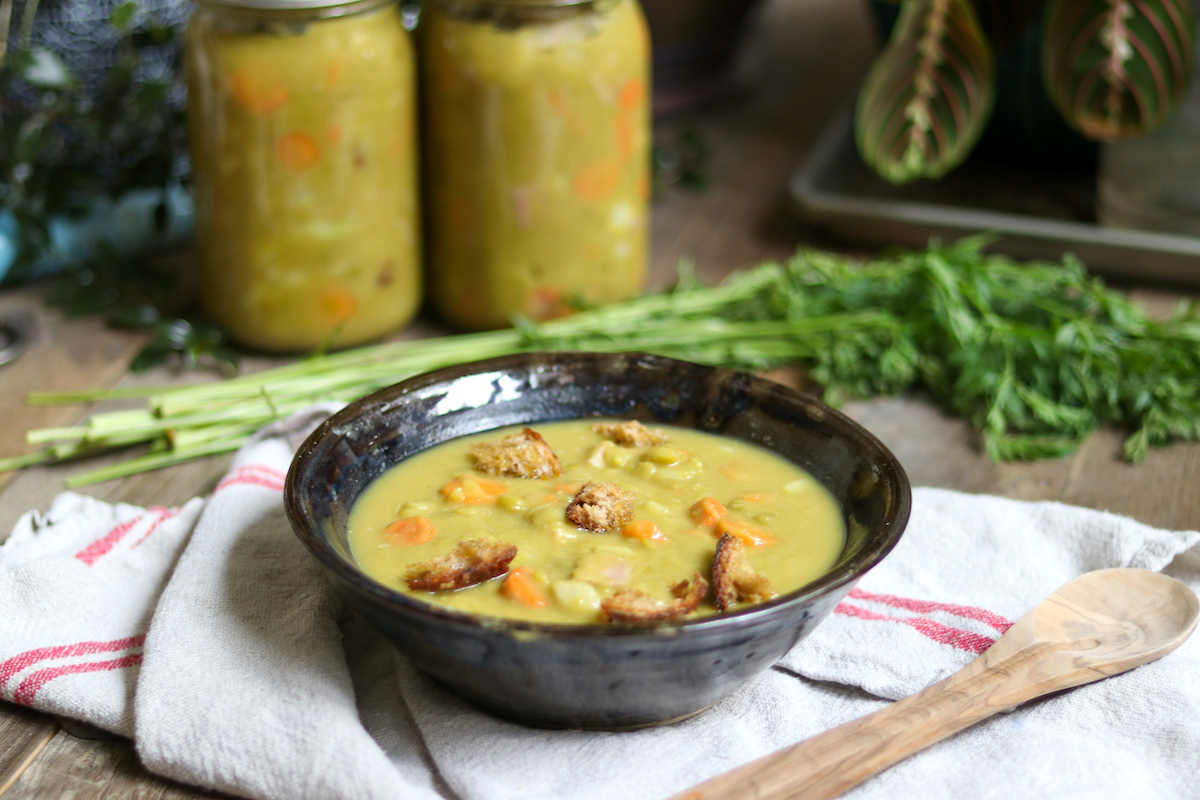
Is Split Pea Soup Safe for Canning?
There is a tested and canning approved recipe for split pea soup developed by Ball Canning (or Bernardin, as they’re known outside the US, they call this recipe “Habitant Soup”). The tested recipe is listed in The Ball Blue Book of Canning, which has literally dozens of meal in a jar recipes like this one.
There’s also a slightly different version listed in Angi Schneider’s Pressure Canning for Beginners and Beyond. Angi’s version uses different seasonings, which is allowed when canning. You’re allowed to adjust the seasoning in tested recipes, adding reasonable amounts of dry spices, as well as things like Worcestershire sauce, vinegar, lemon juice and other salty or acidic liquid condiments.
Density can be an issue with home canned soups, especially split pea soup, but this recipe and the canning times were tested to accommodate for that.
Split pea soup tends to be pretty dense in a can, and you often find yourself thinning it out to serve. That’s true for commercially canned split pea soup, as well as when you can split pea soup at home. The recipe suggests continuing to add water as it cooks to keep it thin enough to serve, but gives no specific requirements as to density or pour ability.
Aim for a texture that you can ladle into jars easily, and one that’s about what you’d want to serve without adding water to thin. (It will thicken up in the jars during canning, so aim for slightly thinner than you’d want in the end, or just plan to thin it at reheating.)
Ingredients for Split Pea Soup
The ingredients for this split pea soup canning recipe are pretty simple, and they make a simple soup that’s mostly peas with a bit of carrot and onion for flavor and texture. Added spices are minimal, but you can choose to spice the soup however you wish. There’s also no guidance for salt, as it’s not needed for preservation.
The soup is fully cooked before it goes into the jars, so you should taste it before canning and adjust the salt/spices to your tastes. Tastes vary, and salt recommendations for this amount of soup are anywhere between 2 teaspoons, and go all the way up to 2 tablespoons. I tend to be on the “low sodium” end of the spectrum, but that’s not for everyone. Use your own taste buds as a guide.
The ball blue book recipe is adjusted to a single pound of split peas because that’s how they usually come from the store in 16 oz packages. It makes 5 pint jars, or 2 quarts and a bit.
If you want a full canner batch, you’ll need to multiply the recipe.
For a single batch, you’ll need the following:
- 1 lb split peas, dry (16 oz package)
- 2 quarts water or broth
- 1 1/2 cups carrots, sliced (about 3 medium)
- 1 cup onion, chopped (about 1 medium)
- 1 cup cooked ham, diced (optional)
- 1 bay leaf
- 1/4 tsp allspice
- Salt and pepper to taste
The seasonings are optional, and reflect traditional tastes for how split pea soup was prepared “back in the day.” Modern tastes tend to liven it up a bit, and often add Worcestershire sauce for savory umami notes, as well as a tablespoon or two of lemon juice or cider vinegar to give it a little acidity which brings out the flavor of the peas.
For dried spices, you can skip the allspice, or double it…as your tastes dictate. Angi Schneider uses sage in place of allspice, as well as a lot of black pepper.
Personally, I like herbal spices like thyme, and I add a good bit of garlic powder and Worcestershire.
The seasonings are up to you, but don’t fiddle with the vegetable ratios. You can omit carrots, onion and ham, as split peas are fine to can on their own rather than as a “soup”…but you can’t add more than is suggested in the recipe.
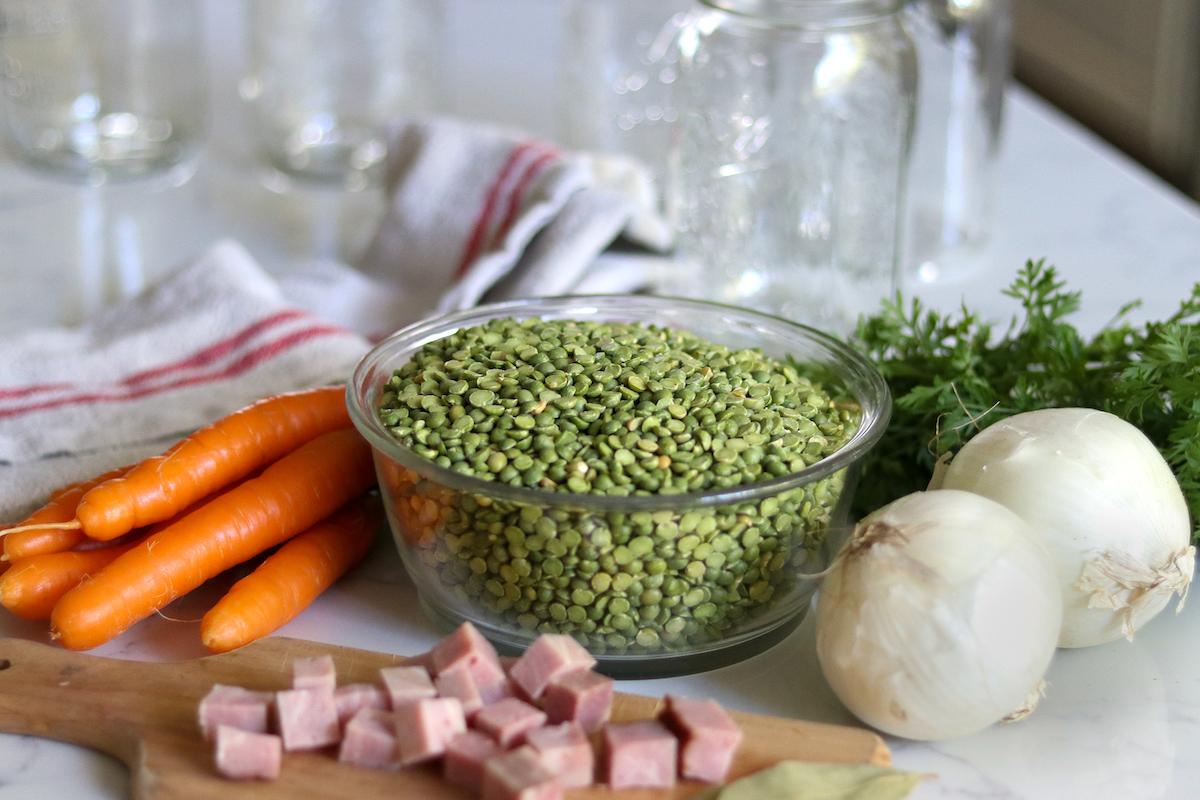
Do You Have to Soak Split Peas?
Soaking split peas isn’t required when canning, and it’s also not required when just making the soup. They re-hydrate well on their own, and this soup is fully cooked before it goes into the canning jars so you don’t have to worry about them re-hydrating further and expanding in the jars.
What I do suggest, and the recipe suggests as well, is rinsing the split peas before cooking. Measure them first, then give them a good rinse in a colander. Pick them over and remove any discolored peas, or other debris if you find it.
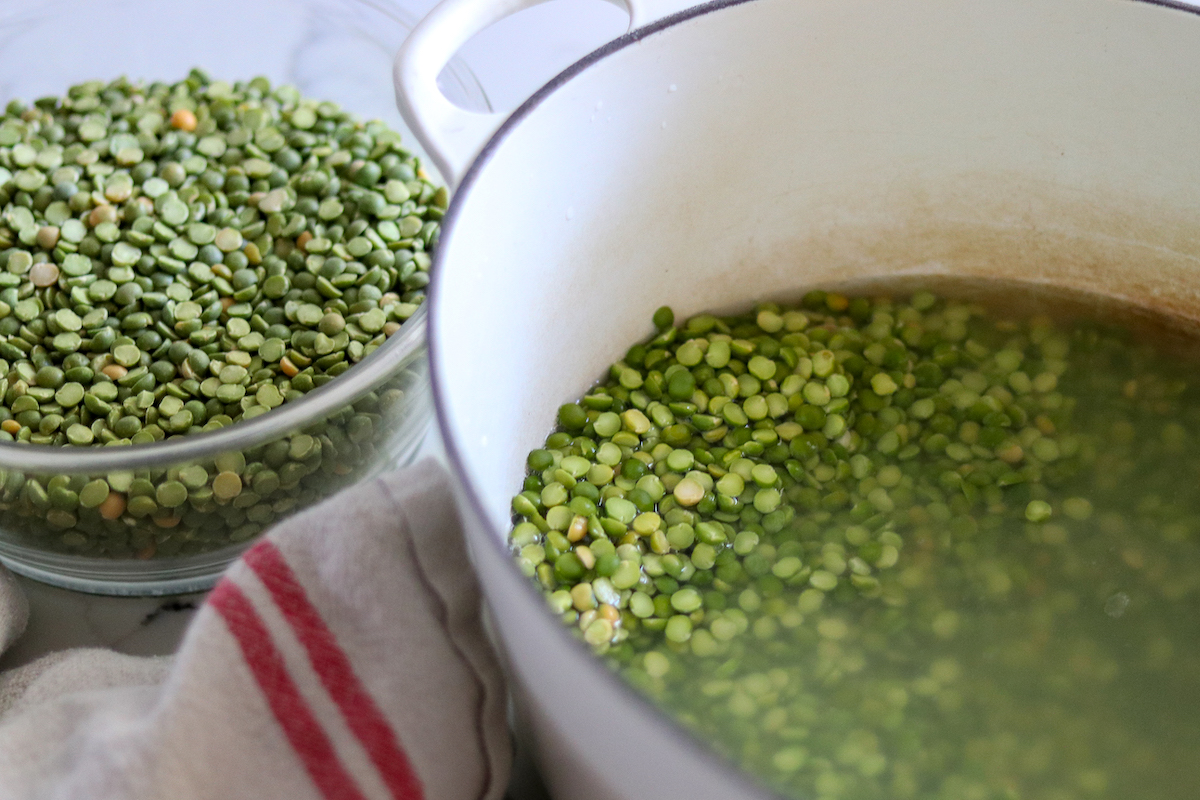
Pressure Canning Split Pea Soup
Making split pea soup for canning starts by cooking the split peas alone in a pot for about an hour covered on a low simmer. You’ll want 1 lb of dry split peas, and two quarts of either water or stock.
Keep the heat low, and add water as necessary to keep the soup from getting too thick.
After an hour, the split peas are cooked. If you want, you can puree them in a blender or with an immersion blender if you want a very smooth soup, or leave them a bit chunky (as is my preference).
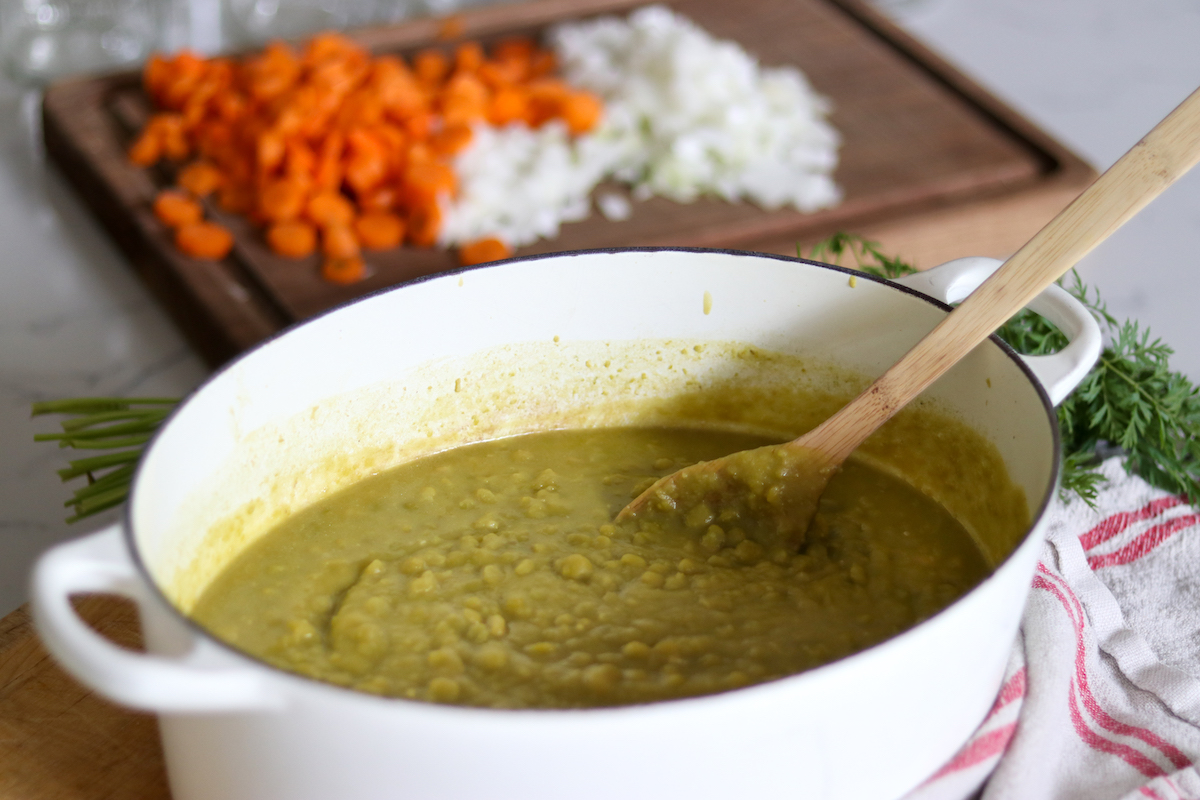
At this point, you’re about 30 minutes away from getting everything into the pressure canner. This is when you should start preparing your pressure canner and pre-heating it for hot pack canning. Follow the manufacturers instructions for your variety of canner, as they’re all a bit different.
In most cases, the canner is prepped by adding a few inches of water to the bottom, putting in the bottom trivet and preheating it to a gentle simmer (around 180 degrees F).
For the soup, the next step is to add the other vegetables and spices.
Make sure you peel the carrots before slicing them, as root vegetables always need to be peeled before canning. Similarly, peel the skin off the onion and dice it too.
Add the vegetable and spices, and continue to simmer the soup for another 30 minutes to fully cook everything. Keep adding water as nessisary to keep it from getting too thick.
After 30 minutes of simmering, it’s time to fill your prepared jars.
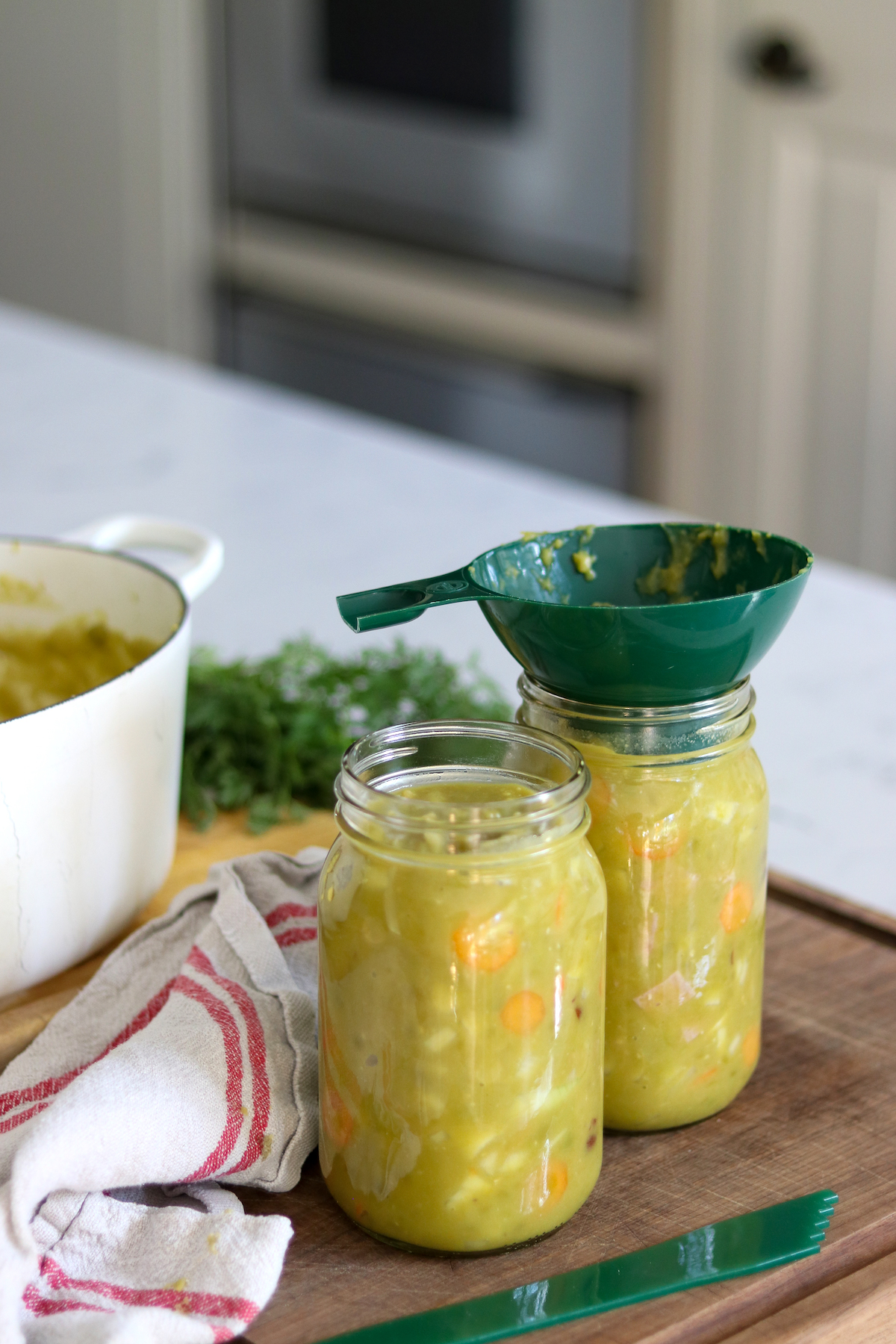
Split pea soup can be canned in pints or quarts. Either way, fill the cleaned, hot jars, leaving 1 inch of headspace.
Cap with 2 part canning lids to finger tight, and load the jars into your pressure canner.
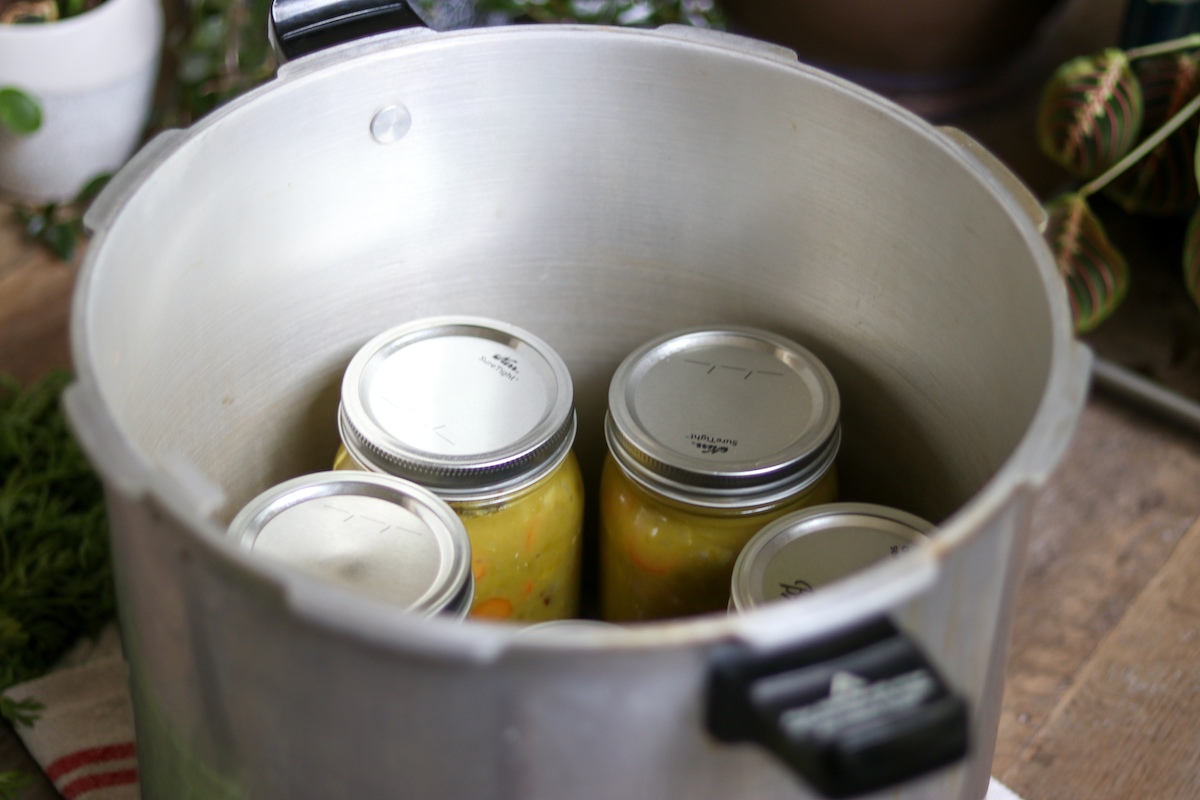
Once the split pea soup has been loaded into the pressure canner, seal up the lid according to the manufacturer’s instructions.
For mine, I tighten all the bolts and then allow the unit to steam out the vent pipe for 10 minutes before adding the canning weight. This ensures that the chamber is completely filled with steam and will heat to an even temperature (without any colder air pockets).
After steam release, I add the canning weight to the pressure appropriate for my altitude and then process for 75 minutes for pints or 90 minutes for quarts.
Altitude Adjustments
When pressure canning, the canning time always stays the same regardless of altitude. The thing you change is the canning pressure, and you use higher pressures at higher altitudes.
Altitude adjustments for pressure are as follows:
For dial gauge pressure canners:
- 0 to 2,000 feet in elevation – 11 lbs pressure
- 2,001 to 4,000 feet in elevation – 12 lbs pressure
- 4,001 to 6,000 feet in elevation – 13 lbs pressure
- 6,001 to 8,000 feet in elevation – 14 lbs pressure
For weighted gauge pressure canners:
- 0 to 1,000 feet in elevation – 10 lbs pressure
- Above 1,000 feet – 15 lbs pressure
Serving Home Canned Split Pea Soup
For the most part, split pea soup is just a heat and eat type of soup. Some recipes, like home canned chicken soup, are served over rice or noodles, but split pea soup does pretty well on it’s own.
I like to eat it with a well buttered slice of whole grain bread, but it also does well served with some toasted croutons tossed in.
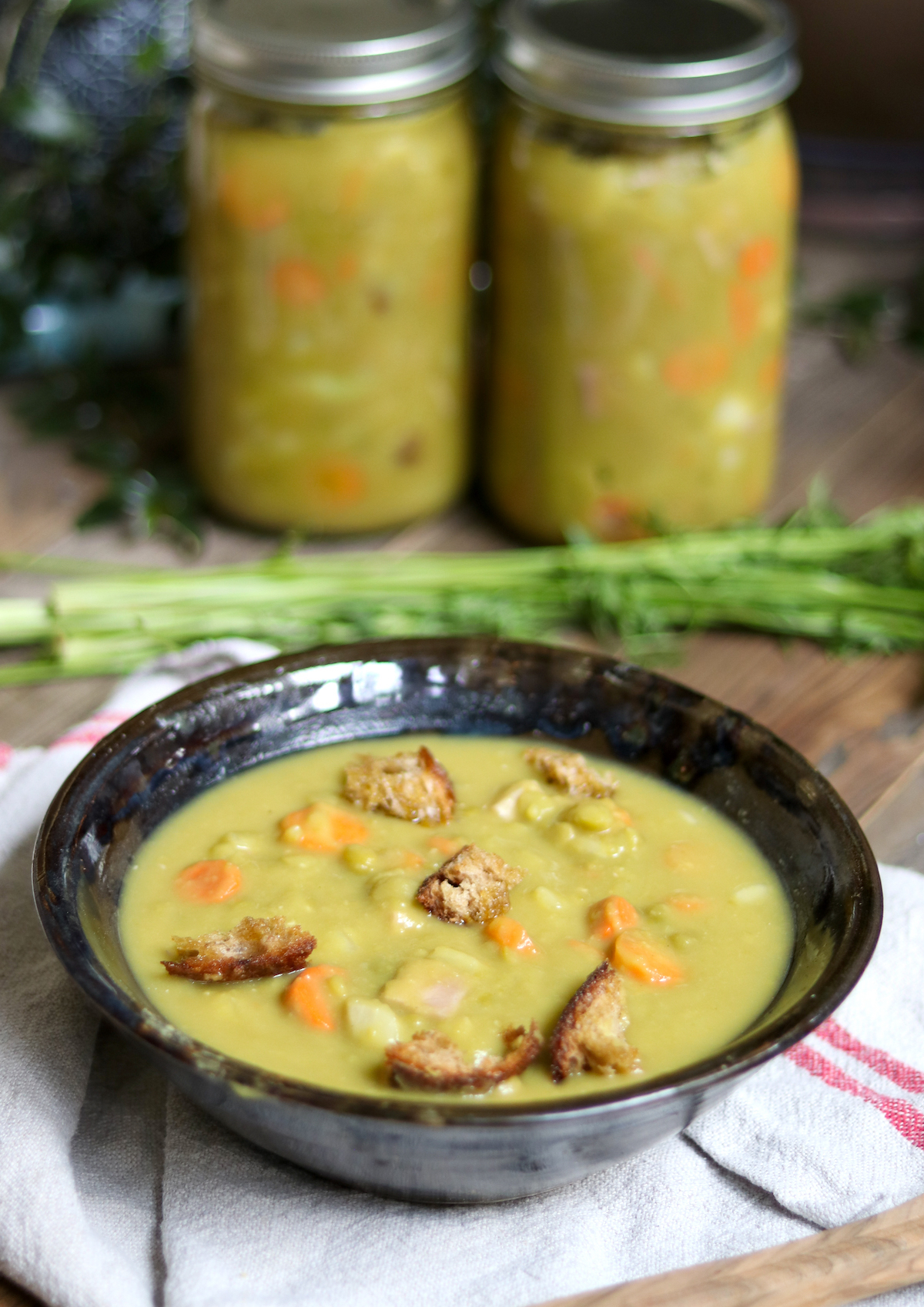
Split Pea Soup Canning Yield
The yield will vary a bit for this recipe as sometimes it’s thinned out to satisfy personal tastes. One “batch” with a single pound of split peas is supposed to make about 5 pint jars, or 2 quarts plus a bit.
If you’re canning in quarts, I’d suggest thinning the soup out a bit more so you get a full 3 quarts.
This recipe can be doubled, tippled or quadrupled to make enough to fill a full canner batch. The size of the recipe depends on the size of pot you have to cook the split peas, and the size of canner you have available.
(I have a 30 Quart All American Canner, which can hold 14 quarts of 19 pints, so I tend to do bit batches.)
I’ve kept the recipe in it’s original “small batch” form, but feel free to increase it as you need. Just be sure to stir the split pea soup as it cooks so it doesn’t burn to the bottom of your pot.
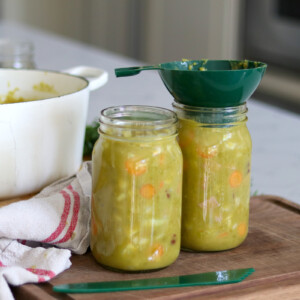
Canning Split Pea Soup
Equipment
Ingredients
- 1 lb split peas, dry (16 oz package)
- 2 Quart water or broth
- 1 1/2 cup carrots, sliced (about 3 medium)
- 1 cup onion, chopped (about 1 medium)
- 1 cup cooked ham, diced (optional)
- 1 bay leaf
- 1/4 tsp allspice
- Salt and pepper to taste
Instructions
- Place split peas in a heavy bottomed stock pot with two quarts of either water or broth. Bring to a boil, then turn to low and simmer gently for 1 hour until the peas are completely cooked.
- (Optional) For a smooth soup, puree in a blender or with an immersion blender.
- Peel and slice the carrots, and peel and dice the onions. Measure out 1 1/2 cups sliced carrots and 1 cup diced onion. Add to the pot.
- Add the spices, either those listed in the recipe or dry spices of your choosing.
- At this point, you're 30 minutes away from canning, so prepare your pressure canner and pre-heat it for hot pack canning. (Follow manufacturers instructions.)
- Simmer the soup for an additional 30 minutes until the vegetables are fully cooked. (Add boiling water as nessisary to keep the mixture from getting too thick.)
- Adjust spices and add salt to taste. Remove the bay leaf at this point, if used.
- Ladle the split pea soup into prepared canning jars, either pints or quarts, leaving 1 inch headspace.
- Seal with 2 part canning lids to finger tight.
- Load the jars into the canner and close the lid. Turn the stove up to high and vent steam for 10 minutes.
- Seal the canner and bring it up to pressure. When at pressure (see notes below), start timer and process the jars for 75 minutes for pints and 90 minutes for quarts.
- When the processing time is complete, turn off the heat and allow the canner to come to room temperature naturally.
- When cool, remove the jars from the canner and check seals. Store any unsealed jars in the refrigerator for immediate use.
- Properly pressure canned and sealed jars of split pea soup should maintain quality on the pantry shelf for 18 months, and be safe to eat much longer provided they're still sealed. Refrigerate after opening.
Notes
Yield
This tested recipe makes 5 pints, or a bit more than 2 quarts. If canning in quarts, I’d suggest adding more broth to thin the soup out a bit and yield a full three quarts. (Or you can double the recipe as is to yield 5 quarts.)Ingredient Notes
The seasoning, spices, and salt in this recipe can be altered to suit your personal tastes. The soup is fully cooked before it goes into the canning jars, so taste it and adjust spicing before canning. I’d suggest starting with around 1-2 teaspoons of salt and increasing from there if you feel it needs more. For spices, dried herbs like sage and thyme work well. Ham is optional, and can be omitted for a vegetarian split pea soup.Altitude Adjustments
The canning time is always the same, 75 minutes for pints and 90 minutes of quarts, regardless of altitude. Pressure changes at higher altitudes. Altitude adjustments for pressure are as follows:For dial gauge pressure canners:
- 0 to 2,000 feet in elevation – 11 lbs pressure
- 2,001 to 4,000 feet in elevation – 12 lbs pressure
- 4,001 to 6,000 feet in elevation – 13 lbs pressure
- 6,001 to 8,000 feet in elevation – 14 lbs pressure
For weighted gauge pressure canners:
- 0 to 1,000 feet in elevation – 10 lbs pressure
- Above 1,000 feet – 15 lbs pressure
Nutrition
Nutrition information is automatically calculated, so should only be used as an approximation.
Lovely pictures in this post by Chez LaRae.
Soup Canning Recipes
Looking for more soup canning recipes? I’ve got plenty for you!
- Beef Stew Recipe for Canning
- Classic Vegetable Soup
- Carrot and Fennel Soup
- Spicy Tomato Vegetable Soup
- Roasted Tomato Basil Soup
Pressure Canning Recipes
Keep your pressure canning running with these simple pressure canning recipes!
- Canning Chicken
- Canning Thai Red Curry Duck
- Canning Potatoes
- Canning Carrots
- Canning Corn
- Canning Sweet Potatoes
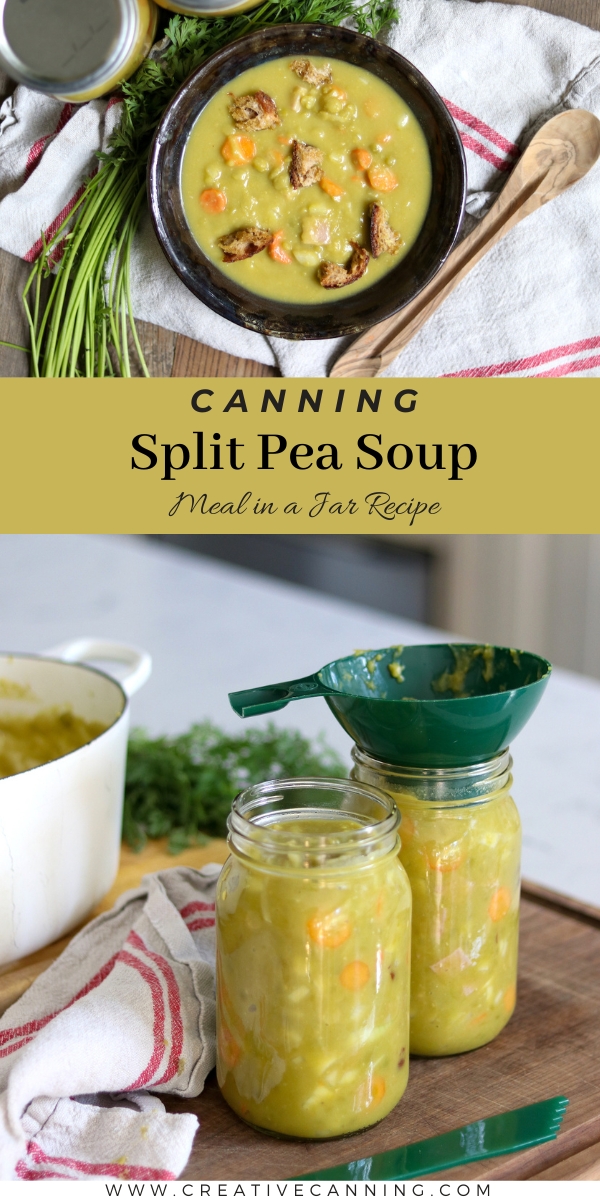
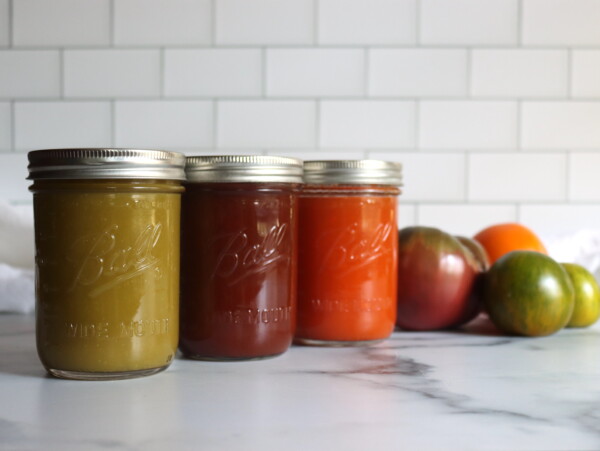
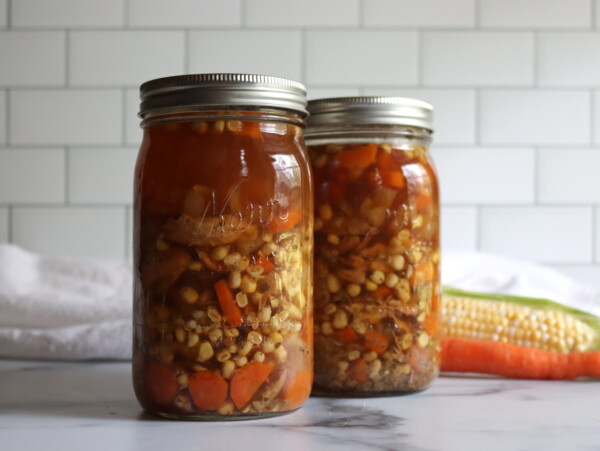
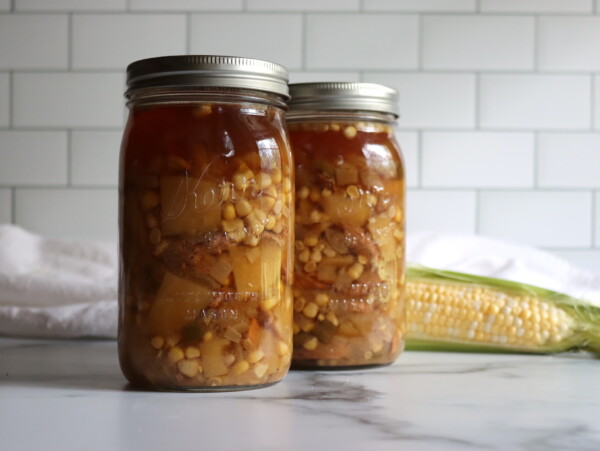
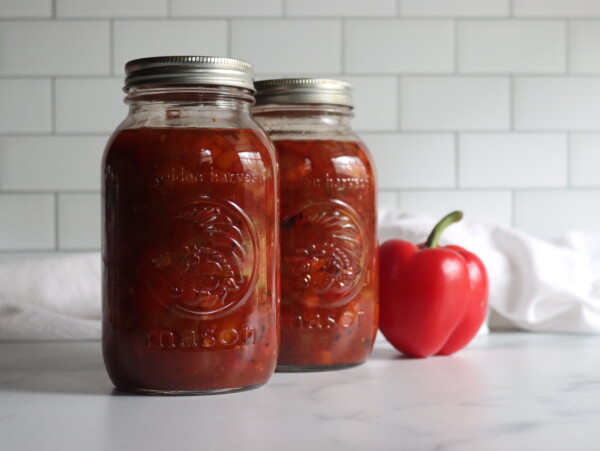
This is so good! I have canned this several times and reach for it often on the shelves.
So glad you like it!
Turned out GREAT!!!!!
Lovely, so glad you enjoyed it!
How many pint jars?
This recipe makes 5 pints of very thick soup. You can thin it out at serving, or thin it before you can it for a higher yield.
What is the processing time if made without meat?
The process time is the same with or without meat. Split peas (and other legumes) actually have a longer canning time than meat, so that’s what’s driving the time here.
I followed the directions and canned my pea soup when it came out it was brown in the jars. Why is that?
Browning in jars is due to over pressure, meaning that the canner was hotter than is required for your elevation. Or, your particular batch of split peas was just extra sweet. It’s brown because the natural sugars in the peas caramelized. This happens a lot when canning corn, or potatoes, which also can have variable amounts of natural sugars in there too.
Perfectly fine to eat, and might even be tastier…but unfortunately not as pretty in the jar.
Could bacon be used instead of ham? If so should the bacon be fried/cooked before adding to recipe?
Yes, you could use an the same amount of bacon in place of the ham. Dice the bacon as purchased from the package and measure out a cup of it before you cook. You can fry the bacon or add it as is, up to you. Personally, I’d crisp it before adding it in, but measure it before you crisp it. Enjoy!
Hello, very informative recipe! I use one of the big pots with a rack for the boiling water method when canning. Would I still process for 75 – 90 mins? Thanks in advance.
This recipe cannot be canned in a water bath canner. Soups of any kind are low in acid, and they need a higher temperature for canning. You must use a pressure canner if canning this recipe.
I canned split pea soup. As I was taking the lid off the canner, some soup was ozzing out of the jars. I set them on the counter to cool off – all of them sealed. Now I don’t know what to think or do! They are sealed, but are they really? Are they safe??
That can happen sometimes, but so long as the jars are still sealed, they’re considered safe to store. You can read more on siphoning here: https://www.healthycanning.com/loss-of-liquid-during-home-canning/
I canned the recipe times 3 for 9 qts and followed the recipe and canning time and pressure exactly. After the jars cooled the soup is a solid mass. The jars are sealed, are they safe to store and eat? PS: first time canning split pea with ham soup.
Yes, that’s normal. Depending on your split peas, the recipe can come out really thick, and that’s how it was traditionally made and canned. It’s thinned at serving, or heated and eaten as is for a really hearty meal.
I pressure canned 7 quarts of this split pea soup yesterday and after coming out of the pressure canner it is no longer green but more of a brown color, any idea why?
That can happen to veggies in the pressure canner. It’s most common with corn, potatoes and sweet potatoes, but it can happen to peas if they’re quite sweet or if the canner is run a bit hot. The sugars in the veggies are caramelizing at high temperature, so they brown. Flavor wise, it should be the same and it’s fine safety wise so long as the jars are sealed. If you’re using a weighted guage pressure canner, and you are just above the line for 10 pounds (thus have to use 15 pounds) the processing heat is higher and can cause that. Or, simply sweeter peas than average, which is hard to control in a bag of split peas from the grocery store.
Can I can pea soup without a pressure canner?
Nope. All soup recipes (or anything that has meat or vegetables) requires a pressure canner.